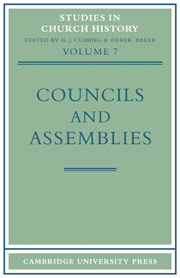Book contents
- Frontmatter
- Preface
- Contents
- Contributors
- Abbreviations
- Public welfare and social legislation in the early medieval councils (Presidential Address)
- National synods, kingship as office, and royal anointing: an early medieval syndrome
- The case of Berengar of Tours
- Ecclesiastica and Regalia: Papal investiture policy from the Council of Guastalla to the First Lateran Council, 1106–23
- Viri religiosi and the York election dispute
- Councils and synods in thirteenth-century Castile and Aragon
- The Byzantine reaction to the Second Council of Lyons, 1274
- The Council of London of 1342
- Education in English ecclesiastical legislation of the later Middle Ages
- The representation of the universitas fidelium in the councils of the conciliar period
- Nicholas Ryssheton and the Council of Pisa, 1409
- The condemnation of John Wyclif at the Council of Constance
- Some aspects of English representation at the Council of Basle
- The Council of Basle and the Second Vatican Council
- The Colloquies between Catholics and Protestants, 1539–41
- King James I's call for an ecumenical council
- John Hales and the Synod of Dort
- Assembly and Association in Dissent, 1689–1831
- The Convocation of 1710: an Anglican attempt at counter-revolution
- Laymen in synod: an aspect of the beginnings of synodical government in South Africa
- The First Vatican Council
- Kikuyu and Edinburgh: the interaction of attitudes to two conferences
Education in English ecclesiastical legislation of the later Middle Ages
Published online by Cambridge University Press: 12 March 2010
- Frontmatter
- Preface
- Contents
- Contributors
- Abbreviations
- Public welfare and social legislation in the early medieval councils (Presidential Address)
- National synods, kingship as office, and royal anointing: an early medieval syndrome
- The case of Berengar of Tours
- Ecclesiastica and Regalia: Papal investiture policy from the Council of Guastalla to the First Lateran Council, 1106–23
- Viri religiosi and the York election dispute
- Councils and synods in thirteenth-century Castile and Aragon
- The Byzantine reaction to the Second Council of Lyons, 1274
- The Council of London of 1342
- Education in English ecclesiastical legislation of the later Middle Ages
- The representation of the universitas fidelium in the councils of the conciliar period
- Nicholas Ryssheton and the Council of Pisa, 1409
- The condemnation of John Wyclif at the Council of Constance
- Some aspects of English representation at the Council of Basle
- The Council of Basle and the Second Vatican Council
- The Colloquies between Catholics and Protestants, 1539–41
- King James I's call for an ecumenical council
- John Hales and the Synod of Dort
- Assembly and Association in Dissent, 1689–1831
- The Convocation of 1710: an Anglican attempt at counter-revolution
- Laymen in synod: an aspect of the beginnings of synodical government in South Africa
- The First Vatican Council
- Kikuyu and Edinburgh: the interaction of attitudes to two conferences
Summary
Provincial and diocesan legislation provided a coherent system of religious education at a time when opportunities for study were few. It is true that in content little was new, but there was much in the way of reiteration, development and expansion, with particular attention to the practical details of implementation.
Mediaeval education is often discussed in terms of clerical education on the one hand, and of lay education on the other. In this context they are one. The priest had first to learn before he could teach, and what was taught can roughly be summed up as faith, morals, and knowledge of the Church's law. It remains true that some things were more appropriate for the clerical than the lay ear. Thus Peter des Roches, Bishop of Winchester (1205–38), required priests to expound the Trinity, the Passion and the Incarnation, but only ‘secundum quod convenit laicis’, while Archbishop Pecham ordered that Ottobon's constitution on clerical concubinage should be published quarterly in rural chapters ‘exclusis tamen laicis’. As Lyndwood explains, the same information could be treated on two levels. Everyone should know the articles of faith, but he who had the cure of souls, with the responsibility of instructing others, must know them ‘explicit e et distincte’, that is, in such a manner as to be able to explain and support them. It sufficed for others, ‘simplices vel laid’, that they should believe such articles ‘implicite’. In any case there is convenience in the separate treatment of clerical and lay education in so far as the manner of instruction is concerned.
- Type
- Chapter
- Information
- Councils and Assemblies , pp. 161 - 176Publisher: Cambridge University PressPrint publication year: 1970



